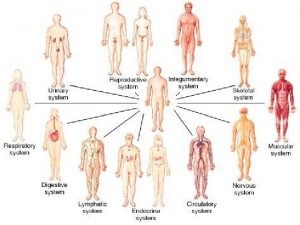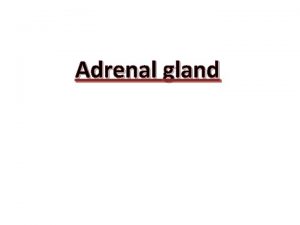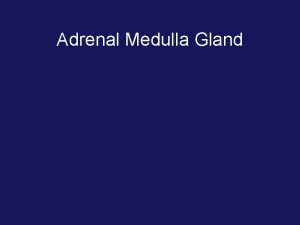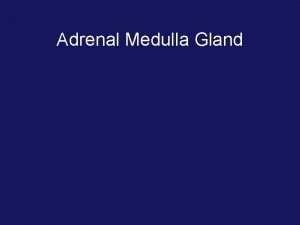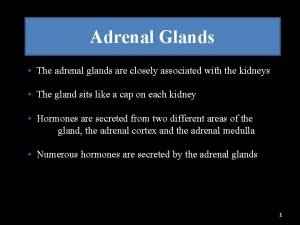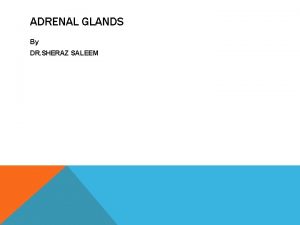Adrenal Gland Description Adrenal glands are triangular shaped












- Slides: 12

Adrenal Gland

Description • Adrenal glands are triangular shaped endocrine glands that measure about 3 inches in length, and a half inch in height. • The two glands are separated with one being on each kidney. • They are made up of an inner layer called the adrenal medulla and an outer layer called the adrenal cortex.


Role of Adrenal Glands in the Body • Adrenal Medulla • The adrenal medulla is made up of chromaffin cells which are the bodies main source of catecholamine hormones. • These hormones are adrenaline (epinephrine) and noradrenaline (norepinephrine). • These are powerful “fight or flight” hormones initiated by the sympathetic nervous system that play a key role in short-term stress reaction. • They’re release is triggered from the adrenal glands when danger threatens you, high stress or emergency situations. • They lack distinct synapses, instead releasing secretions directly into the blood


Epinephrine + Norepinephrine • Epinephrine • • • Also referred to as adrenaline, acts as a hormone and a neurotransmitter. Derived from the amino acid tyrosine. When in the bloodstream, it quickly prepares the body for action in emergency situations. The hormone increases the supply of oxygen and glucose to the brain and muscles. It increases heart rate and stroke volume, dilates the pupils, and constricts arterioles in the skin. Breaks down lipids in fat cells Does not have psychoactive effects (does not alter brain function) • Norepinephrine • Also referred to as noradrenaline, acts as a hormone and a neurotransmitter. • A stress hormone very similar to epinephrine except it affects parts of the brain where attention and responding actions are controlled. • Therefore has psychoactive effects.

Adrenal Cortex • Made up of 3 layers • Outside layer produces mineralocorticoids such as Aldosterone which affects the metabolism in different ways. • It’s release is triggered by high extracellular pottasium, low extracellular sodium, and low fluid levels. • The middle layer produces corticosteroid hormones from cholesterol. • These include cortisol which responds to stress and anxiety. • It increases blood pressure and blood sugar, and reduces immune responses. • Several synthetic forms of cortisol are used to treat a variety of different illnesses such as cortisone acetate. • The deepest layer of the adrenal cortex is a secondary producer of androgens. These include hormones such as testosterone which are primarily produced elsewhere.


Damage/Malfunction of Gland • Cushing Syndrome • Too much cortisol is produced. • Symptoms vary, but most people have upper body obesity, rounded faces, increased fat around neck, and thinning arms and legs. • Weakening of the bones and easy bruising of the skin is also common. • Cushing Syndrome is caused by either an abnormality in the adrenal cortex such as a tumor, or because the pituitary gland is producing too much ACTH (the hormone that causes the adrenal cortex to produce cortisol).

Addison Disease • Occurs when adrenal cortex does not produce enough cortisol. • Symptoms include weight loss, muscle weakness, fatigue, low blood pressure, and sometimes darkening of the skin. • This could be caused again by adrenal cortex abnormalities or inadequate secretion of ACTH. • If symptoms worsen suddenly due to a stressful event (addisonian crisis) it can be fatal


Waterhouse-Friderichsen Syndrome • An adrenal gland failure due to bleeding into the adrenal gland. • Caused by extreme infections. • Symptoms include profound shock and is deadly if not treated immediately.


